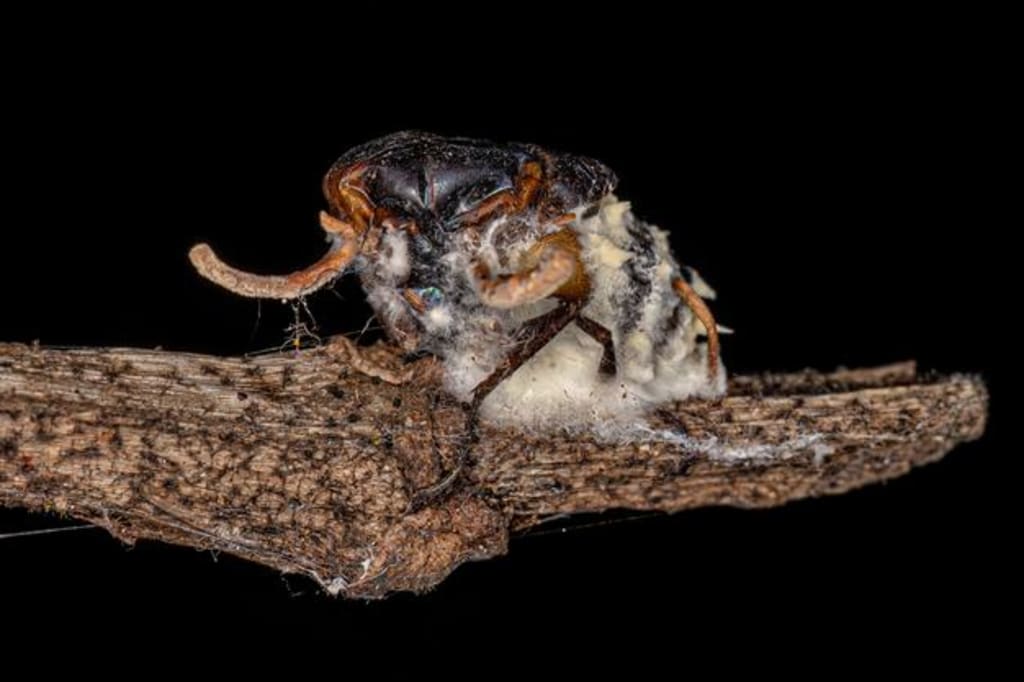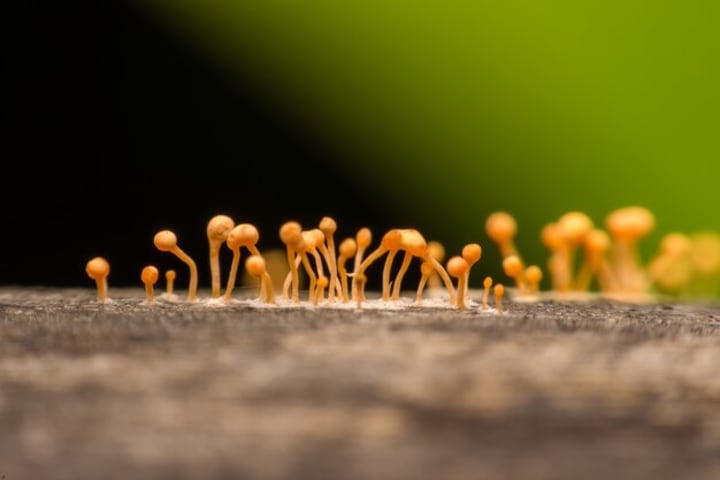
Ophiocordyceps is a genus of fungi in the family Ophiocordycipitaceae. These fungi are known for their ability to infect and manipulate the behavior of insects, particularly ants. They are commonly referred to as "zombie ant fungi" because they take over the ant's nervous system and force the insect to climb to the top of a plant and attach itself to a leaf before dying. The fungus then grows out of the ant's head and releases spores to infect other ants.
Ophiocordyceps species are found in many tropical regions, including the Amazon rainforest and the Asian tropical forests. These fungi are parasites that infect various species of ants, causing them to climb to a suitable location for the fungus to grow.
Some species of Ophiocordyceps fungi are also known to have medicinal properties, they have been traditionally used to treat various ailments such as cancer, diabetes, and hypertension. Due to the potential medicinal properties and the unique lifestyle of the fungus, it is a subject of ongoing research.
It is worth noting that Ophiocordyceps unilateralis is the species that is commonly known as "zombie ant fungus" and has been widely covered in the media.
1. The life cycle and behavior manipulation of Ophiocordyceps fungi in ants.
2. The diversity of Ophiocordyceps species and their host range.
3. The role of Ophiocordyceps fungi in tropical ecosystems.
4. The medicinal properties of Ophiocordyceps and its potential as a source of new drugs.
5. The impact of deforestation and habitat destruction on Ophiocordyceps fungi populations.
6. The genetic and molecular mechanisms of host manipulation by Ophiocordyceps fungi.
7. The use of Ophiocordyceps fungi in biocontrol of pest insects.
8. The cultural and traditional uses of Ophiocordyceps fungi in different cultures.
9. The effect of climate change on the distribution and survival of Ophiocordyceps fungi.
10. The potential application of Ophiocordyceps fungi in biotechnology and agriculture.

1. The life cycle and behavior manipulation of Ophiocordyceps fungi in ants: Ophiocordyceps fungi are known for their ability to infect and manipulate the behavior of ants, particularly in the tropical regions. The fungus infects the ant's nervous system and forces the insect to climb to the top of a plant and attach itself to a leaf before dying. The fungus then grows out of the ant's head and releases spores to infect other ants. This fascinating phenomenon is known as "zombie ant fungus" and has been widely studied in recent years. Studies have shown that different species of Ophiocordyceps fungi have evolved to infect different species of ants, each with its unique life cycle and manipulation strategy. Research on the life cycle and behavior manipulation of Ophiocordyceps fungi could provide new insights into the interactions between parasites and their hosts, as well as the evolution of host manipulation.
2. The diversity of Ophiocordyceps species and their host range:
Ophiocordyceps is a genus of fungi that comprises around 400 species. These fungi are known for their ability to infect and manipulate the behavior of a wide range of insects, particularly ants. The diversity of Ophiocordyceps species is found in many tropical regions, including the Amazon rainforest and the Asian tropical forests.
Different species of Ophiocordyceps fungi have evolved to infect different species of ants, each with its unique life cycle and manipulation strategy. Research on the diversity of Ophiocordyceps species and their host range could provide new insights into the evolution of host specificity and the diversity of interactions between parasites and their hosts. Studies of these fungi also help to understand the impact of the fungi on the host population and the ecosystem.
Research on the diversity of Ophiocordyceps species and their host range is important to understand the distribution of these fungi and how they interact with the host and other organisms in the ecosystem. It also helps to understand how these fungi adapt to different habitats and how they are affected by environmental changes.
3. The role of Ophiocordyceps fungi in tropical ecosystems:
Ophiocordyceps fungi are known for their ability to infect and manipulate the behavior of insects, particularly ants, in tropical regions. These fungi are found in many tropical regions, including the Amazon rainforest and the Asian tropical forests. The fungus infects the ant's nervous system and forces the insect to climb to the top of a plant and attach itself to a leaf before dying. The fungus then grows out of the ant's head and releases spores to infect other ants.
Ophiocordyceps fungi play an important role in tropical ecosystems by controlling the population of ants and other insects. They also contribute to the nutrient cycling in tropical forests by breaking down the dead insects and returning their nutrients to the soil.
The diversity of Ophiocordyceps species in tropical regions and the wide range of insects they infect also make them an important component of biodiversity in these ecosystems. The study of these fungi and their interactions with other organisms in tropical ecosystems can provide new insights into the functioning of these ecosystems and the relationships between different species.
Research on the role of Ophiocordyceps fungi in tropical ecosystems is important to understand the impact of these fungi on the ecosystem and how they are affected by environmental changes such as deforestation and climate change.

4. The medicinal properties of Ophiocordyceps and its potential as a source of new drugs:
Ophiocordyceps fungi have been used in traditional medicine for centuries, particularly in Asia. These fungi have been used to treat a wide range of conditions, including fatigue, asthma, and cancer. Some species of Ophiocordyceps have been found to have anti-inflammatory, immunomodulatory, and anti-cancer properties.
Modern research has also revealed that Ophiocordyceps fungi contain a variety of biologically active compounds, including polysaccharides, nucleosides, and peptides, which have potential therapeutic applications. These compounds have been found to have anti-inflammatory, immunomodulatory, and anti-cancer properties.
Ophiocordyceps fungi are considered as a promising source of new drugs for the treatment of various diseases. Studies on the medicinal properties of Ophiocordyceps fungi and the isolation of active compounds from these fungi could lead to the development of new drugs for the treatment of various diseases, such as cancer and infectious diseases.
Research on the medicinal properties of Ophiocordyceps fungi and its potential as a source of new drugs is important for understanding the biological activity of these fungi and how they can be used to improve human health. This research could also help to preserve traditional knowledge of using Ophiocordyceps fungi in medicine and to find new ways to use these natural resources to benefit human health.

5. The impact of deforestation and habitat destruction on Ophiocordyceps fungi populations:
Ophiocordyceps fungi are found in many tropical regions, including the Amazon rainforest and the Asian tropical forests. These fungi are dependent on their host insects, which are found in these regions. Deforestation and habitat destruction have a negative impact on Ophiocordyceps fungi populations by reducing the number of host insects and altering the environment in which they live.
Deforestation and habitat destruction can also lead to changes in the microclimate, such as changes in temperature and humidity, which can affect the growth and reproduction of Ophiocordyceps fungi. It also increases the risk of exposure of the fungus to pathogens and predators.
Furthermore, fragmentation of habitats causes loss of biodiversity and genetic diversity of Ophiocordyceps fungi which can have an impact on the population and ecosystem.
Research on the impact of deforestation and habitat destruction on Ophiocordyceps fungi populations is important to understand the impact of these environmental changes on the fungi and their host insects. It can also help to identify the most vulnerable populations and to develop strategies to protect them. This research could also help to understand how these fungi are affected by climate change and how they can be conserved for future generations.
6. The genetic and molecular mechanisms of host manipulation by Ophiocordyceps fungi:
Ophiocordyceps fungi are known for their ability to manipulate the behavior of their host insects, particularly ants. This is achieved through the secretion of various compounds that affect the host's nervous system. However, the genetic and molecular mechanisms of host manipulation by Ophiocordyceps fungi are not well understood.
Recent research has begun to shed light on the genetic and molecular mechanisms of host manipulation by Ophiocordyceps fungi. Studies have shown that these fungi produce a variety of molecules that affect the host's nervous system, including neurotransmitters and neuropeptides. Some studies suggest that the fungi may also produce enzymes that degrade the host's nervous system, allowing the fungus to take control.
Research on the genetic and molecular mechanisms of host manipulation by Ophiocordyceps fungi is important to understand how these fungi are able to control the behavior of their host insects. This research could also lead to new insights into the functioning of the insect nervous system and the ways in which it can be manipulated. Additionally, studying these mechanisms can give a better understanding of the evolutionary process behind this phenomenon.
Understanding the genetic and molecular mechanisms of host manipulation by Ophiocordyceps fungi could also have implications for the control of insect pests and the development of new methods for controlling insect populations.
7. The use of Ophiocordyceps fungi in biocontrol of pest insects:
Ophiocordyceps fungi are known for their ability to manipulate the behavior of their host insects, particularly ants, and this has led to interest in using these fungi as a form of biocontrol for pest insects. Biocontrol is the use of living organisms, such as fungi, to control pest populations.
Research has shown that Ophiocordyceps fungi can effectively infect and kill a variety of pest insects, including termites, beetles, and caterpillars. These fungi can also target specific pest species while leaving beneficial insects unharmed. Additionally, Ophiocordyceps fungi can be mass-produced and distributed over large areas, making them a cost-effective alternative to chemical pesticides.
There are some concerns about the use of Ophiocordyceps fungi in biocontrol, such as the potential impact on non-target species and the environment. Therefore, it's important to conduct thorough testing and monitoring to ensure that any biocontrol measures are safe and effective.
The use of Ophiocordyceps fungi in biocontrol is an exciting area of research with a lot of potential. It could lead to the development of new, environmentally friendly methods for controlling pest populations and reducing the need for chemical pesticides.
8. The cultural and traditional uses of Ophiocordyceps fungi in different cultures:
Ophiocordyceps fungi have been used for centuries in traditional medicine and cultural practices in many parts of the world.
In traditional Chinese medicine, Ophiocordyceps fungi have been used to treat a variety of ailments, including fatigue, impotence, and respiratory disorders. The fungi are believed to have tonic properties that can help to strengthen the body and boost the immune system. They are also thought to have anti-inflammatory and anti-cancer properties.
In Tibet, Ophiocordyceps fungi have been used as a tonic to enhance physical and mental performance and as a treatment for a variety of illnesses. They are also used in traditional rituals and as a powerful symbol of spiritual potency.
In Bhutan, Ophiocordyceps fungi are considered a sacred medicine, and they are used in traditional medicine to treat a variety of illnesses, including cancer, diabetes, and hypertension.
In addition to traditional medicine, Ophiocordyceps fungi have also been used in cultural practices such as traditional Chinese martial arts and traditional Tibetan medicine. They are also used in many cultures as a symbol of good luck and prosperity.
Studying the cultural and traditional uses of Ophiocordyceps fungi in different cultures can provide valuable insights into their medicinal properties and cultural significance. Additionally, it can also help in preserving traditional knowledge, cultural heritage and respect for traditional medicine system.
9. The effect of climate change on the distribution and survival of Ophiocordyceps fungi.
Climate change is having a significant impact on the distribution and survival of many species of organisms, including Ophiocordyceps fungi.
Rising temperatures and changes in precipitation patterns can affect the growth and reproduction of Ophiocordyceps fungi, as well as the survival and behavior of their host insects. For example, warmer temperatures can lead to an earlier onset of the fungi's reproductive phase, which can cause the host insects to die prematurely, leaving the fungi with no host to reproduce on.
Climate change can also affect the distribution of Ophiocordyceps fungi, as changes in temperature and precipitation can alter the suitability of different habitats for the fungi and their host insects. This can lead to the loss of suitable habitats for the fungi and the displacement of populations to new areas.
In addition to these direct effects, climate change can also indirectly affect Ophiocordyceps fungi through changes in the distribution and abundance of other species, such as predators and competitors, that interact with the fungi and their host insects.
Overall, the effect of climate change on Ophiocordyceps fungi is complex and multifaceted, and further research is needed to understand how these fungi will be impacted in the future. It's important to note that a better understanding of the impact of climate change on Ophiocordyceps fungi can help to develop strategies for conservation and management of these fungi.
10. The potential application of Ophiocordyceps fungi in biotechnology and agriculture:
Ophiocordyceps fungi have potential applications in biotechnology and agriculture due to their unique characteristics and properties.
One of the main potential uses of Ophiocordyceps fungi in biotechnology is their ability to manipulate the behavior of their host insects. This ability has led to the development of new strategies for controlling pest insects in agriculture. For example, Ophiocordyceps fungi can be used to infect and control pest insects that damage crops, such as the fall armyworm and the diamondback moth, without the need for chemical pesticides.
Ophiocordyceps fungi also have potential applications in the production of enzymes and other bioactive compounds. For example, Ophiocordyceps fungi produce a wide range of enzymes that have potential industrial applications, such as in the production of biofuels and the degradation of plant biomass. They also produce a wide range of bioactive compounds, such as polysaccharides and cordycepin, that have potential medicinal and industrial applications.
In addition, Ophiocordyceps fungi have been used in traditional medicine and cultural practices, and this is an area of research that could lead to the discovery of new drugs and therapies.
Overall, the potential application of Ophiocordyceps fungi in biotechnology and agriculture is an active area of research, and further studies are needed to fully understand and harness the potential of these fungi in various fields.
DOES IT AFFECT HUMAN BEING?
Ophiocordyceps fungi do not typically have a direct impact on human health. They primarily infect and manipulate the behavior of insects, such as ants and beetles, as part of their natural life cycle. However, in rare cases, Ophiocordyceps fungi have been known to cause infections in humans with weakened immune systems. For example, Ophiocordyceps unilateralis var. unilateralis, which is found in North America and Europe, can cause a rare infection called subcutaneous phaeohyphomycosis. This infection usually affects people with compromised immune systems and can cause a wide range of symptoms, including skin lesions, joint pain, and fever.
It's important to note that Ophiocordyceps fungi are found in nature and are not typically found in the human environment. Also, it's not common for humans to be infected by Ophiocordyceps fungi and the risk of infection is relatively low for healthy individuals.
About the Creator
Enjoyed the story? Support the Creator.
Subscribe for free to receive all their stories in your feed. You could also pledge your support or give them a one-off tip, letting them know you appreciate their work.





Comments
There are no comments for this story
Be the first to respond and start the conversation.